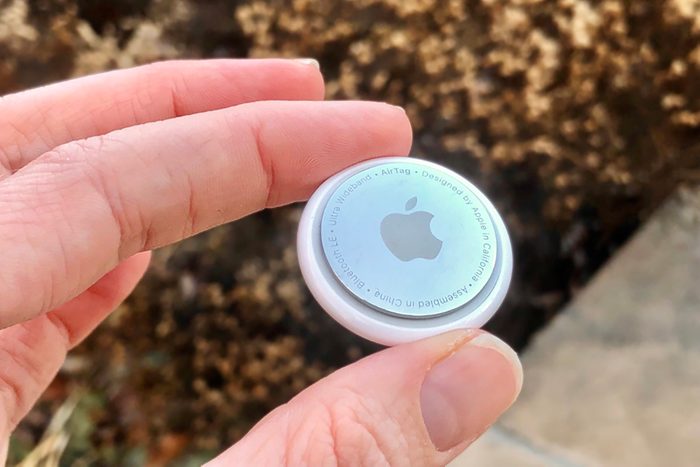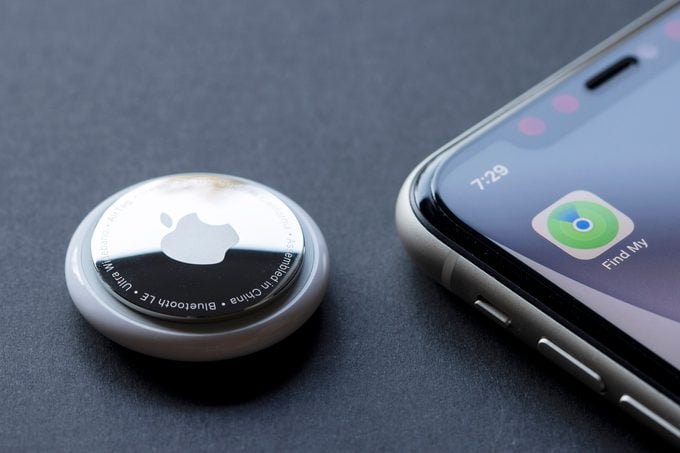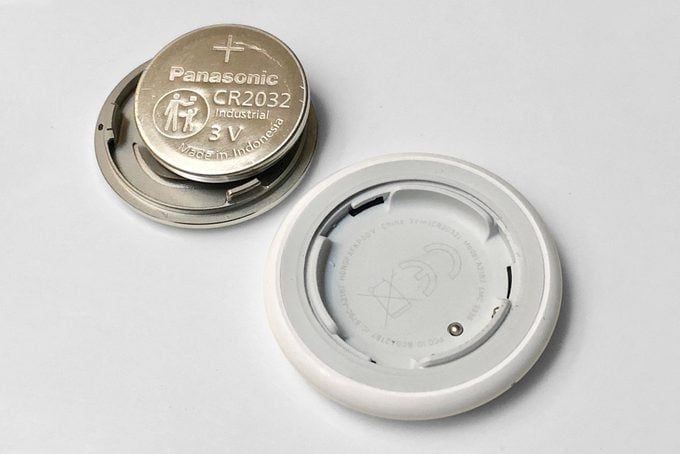How to Detect an AirTag—and Disable It If You’re Being Tracked
Updated: Jun. 06, 2024

Created as a way to help you find lost items, Apple's teeny tracker can also keep an eye on your location—without your permission. Here's how to detect and disable an AirTag.
Let’s face facts: Tech can be used or abused. A 3D printer can create a custom prosthetic to help a child kick a soccer ball, for example, but that same device can also make a gun to get past metal detectors. There’s a similar duality with trackers like Apple’s trendy AirTag. These coin-size devices can help you find your misplaced car keys or monitor missing luggage but—and here’s why it’s crucial to know how to detect an AirTag—they’re also leveraged to track or stalk people without consent.
“While designed to help individuals locate personal belongings, these can be exploited for unauthorized tracking, leading to several critical concerns for everyone,” says Theresa Payton, a renowned cybersecurity expert who served as the first female White House chief information officer. “We have seen cases where they have been stashed in someone’s purse or backpack, vehicles or workplaces, enabling unauthorized individuals to monitor movements and activities without their knowledge.”
If you suspect someone has placed an AirTag near or on you, don’t panic. I reached out to three people with expertise in cybersecurity, stalkerware and technology-assisted intimate partner abuse to find out not only how to detect an AirTag but also how to disable it and what to do next. With 30 years of experience as a technology reporter, I’m here to translate tough topics and ensure you get the most accurate and relevant information. So read on for the tech tips that’ll keep you safe.
Get Reader’s Digest’s Read Up newsletter for more tech, travel, humor and fun facts all week long.
How to detect an Apple AirTag

Maybe you’ve lost an AirTag—and the keys, pet, purse, luggage or other item tied to it. Or maybe you’re worried someone has slipped the tracking device on you. Don’t despair. Here’s how to find an AirTag using simple methods.
Check for an iPhone alert
![]()
If your iPhone detects someone else’s AirTag nearby, it may display an alert on your screen that says, “AirTag found moving with you. The location of this AirTag can be seen by the owner. Tap to open Find My and see available actions.”
This should happen by default if your phone has Bluetooth turned on, but it doesn’t hurt to double-check that your tracking notifications are enabled. Here’s how:
- Go to Settings.
- Tap “Privacy & Security.”
- Tap “Location Services.”
- Toggle on “Location Services.”
- Scroll down to the bottom of the screen and tap “System Services.”
- Toggle on both “Find My iPhone” and “Significant Locations.”
Play a sound on the AirTag
When your AirTag is within Bluetooth range of your iPhone, you can prompt the AirTag to play a sound, alerting you to its location. Simply tap the “Play Sound” button.
If you get an alert that an AirTag is traveling with you, follow these steps to play a sound to find it:
- Tap the alert.
- Tap “Continue.”
- Tap “Play Sound.”
- Listen for the sound. You can play it again if you need more time to find the item near you.
- If the option to play a sound isn’t available, open the Find My app to see if it allows you to play a sound on the unknown AirTag.
There are a few reasons you may be unable to play a sound on an unknown AirTag:
- The AirTag might not be with you anymore.
- The AirTag’s Bluetooth identifier might have changed.
- The AirTag is within range of its owner.
Use Precision Finding

If you have an iPhone 11 or later model (except for the iPhone SE), you can use Precision Finding to locate an AirTag. If you’re looking for your own device, open up the Find My app, select “Items” and then choose your AirTag. If an iPhone alert says there’s an AirTag detected near you, tap it to open Find My and see the AirTag.
From there, follow these steps to use Precision Finding to help you locate it:
- Tap “Find Nearby.”
- Follow the onscreen instructions, moving around the space until your iPhone connects to the AirTag.
- Follow the displayed distance and direction.
As you get closer to the AirTag, your phone will vibrate. You can up your chances of finding the AirTag quickly by tapping “Play Sound” or turning on your iPhone flashlight if your phone says it’s too dark.
Look the old-fashioned way
If you believe the item is still with you but you can’t hear it or locate it on a map through Precision Finding, it’s time for some old-school sleuthing. Look through your belongings to try to find it. Check your bag, your vehicle or a jacket pocket. And if you feel your safety is at risk, go to a safe public location and contact law enforcement.
It’s good practice to routinely check for these devices, says Payton. “Conduct inspections of personal belongings, vehicles and workspaces to detect and remove any unauthorized tracking devices,” she says. “This should include a thorough check of items such as bags, clothing and equipment.”
How to detect an AirTag on Android
If you have an Android device—such as a Samsung Galaxy phone, Google Pixel, Moto or OnePlus—locating an AirTag may be easier than ever before. In May 2023, Apple and Google teamed up to create an industrywide specification for Bluetooth tracking devices. And this May, they announced the result of that partnership, known as “Detecting Unwanted Location Trackers.”
Available on Android 6.0 and newer phones (as well as on iOS 17.5), the feature notifies users of a nearby tracker with a “tracker traveling with you” alert. Heed the warning! “Even though Apple and Google have implemented ways to notify users when an unknown tracker device is co-located with them over extended periods of time, these can still be abused,” adds Abhishek Karnik, senior director of threat research at cybersecurity company McAfee. “If you receive a notification on your phone for an AirTag, don’t ignore it.”
Here’s what to do when you get a tracking alert on your Android:
- Tap the tracker notification.
- Determine where the tracker has been detected traveling with you.
- Tap “Play sound.”
- Follow the sound to find the tracker.
You can also run a manual scan for trackers:
- Tap “Settings.”
- Tap “Safety & Emergency.”
- Tap “Unknown tracker alerts.”
- Select “Scan now.”
Another option is to download Apple’s Tracker Detect app from the Google Play Store. As the name suggests, the app looks for trackers within Bluetooth range that are separated from their owners and are compatible with Apple’s Find My network. If it detects an AirTag (or other compatible tracker) near you for at least 10 minutes, you can play a sound to help you locate it.
How to locate the serial number of an AirTag

So you found an AirTag on or near you. Now what? “Remain calm and carefully assess your surroundings to ensure you are in a safe location,” says Payton. “Avoid making sudden decisions until you have a clear understanding of the situation.”
We’ll cover how to disable AirTag tracking shortly, but there’s an important step to take first: Use your iPhone or any other smartphone with Near Field Communication (NFC) technology (most these days) to see the AirTag’s information.
- Hold the top of your phone near the white side of the AirTag.
- Wait for your phone to recognize the device.
- A notification will appear on your screen. Tap it to access a website with the AirTag’s serial number and the last four digits of the owner’s phone number.
- Take a screenshot to make sure that you can document the information.
If this is a lost AirTag, the owner might have voluntarily added contact information to let the finder contact them. It’s unlikely a stalker will provide this info, however.
How to disable an AirTag

Before you turn off an AirTag, you need to know what’s about to happen: Once disabled, the device will send a message to its owner.
“If you’re in a dangerous relationship, it’s critical to be mindful of your safety, including possible retaliation,” cautions lawyer Lindsey M. Song, the associate program director of the Queens Family Justice Center Family Law Project at Sanctuary for Families, an organization dedicated to the safety, healing and self-determination of victims of domestic violence and related forms of gender violence. “Because the abuser will know you’ve disabled it, as they no longer will be able to see your location, it could increase your danger, so you might need to find the right time to turn it off and seek domestic abuse resources that are available.”
When you’re in a safe space and have taken a screenshot of the AirTag’s important information, you can disable it by taking these steps:
- Tap “Instructions to disable,” found on the same screen with the AirTag’s serial number.
- Follow the onscreen steps.
Essentially, disabling an AirTag is a matter of removing the battery. You’ll push down and twist the cover counterclockwise to open the AirTag and take out the battery.
After the AirTag is disabled, the owner will no longer receive updates on its current location, and you will no longer receive unwanted tracking alerts for this item.
What to do after you disable an AirTag
After disabling an AirTag that was hidden on you or your property, what you do next is up to you—though McAfee’s Karnik strongly suggests reporting the incident to law enforcement. “This is for your own safety,” he says. “Apple works with law enforcement to identify the owner. And if you’re ever concerned about your safety, reach out to TheHotline.org.”
You will likely need to provide the AirTag’s serial number and the owner’s information, which is why it is so important to take screenshots prior to disabling. You may also need to give the disabled AirTag to the authorities.
FAQs
How do AirTags work?
Apple’s AirTags broadcast a Bluetooth signal that allows you to locate them via Apple’s Find My network. (Find My uses the Bluetooth identifier to determine whether the same item is moving with you.) You can see it on a map in the Find My app, play a sound that you can follow to track it or use “Precision Finding” to learn the distance to and direction of your lost item. If you’ve clipped an AirTag to a wallet that is, say, stuck between the couch cushions, the feature will help you find it.
Of course, the device works outside of the home too. By leveraging the more than 2 billion Apple devices around the globe—iPhones, iPads, Apple Watches and Macs—and using Apple’s crowdsourced Find My network, AirTags detect (from up to 30 feet away) and anonymously report emitted Bluetooth signals to Apple’s iCloud. They then share the AirTag’s location with you.
Do AirTags use GPS?
Nope. They use Bluetooth. But because there are so many Apple products around the world, they collectively can share the location with you, so long as the AirTag is within 30 feet of a device (Bluetooth’s typical range).
How can someone use AirTags to track you?
While Payton suggests they can be used for corporate espionage, trackers like the AirTag and Tile are, perhaps unsurprisingly, popular tools among abusive partners or malicious ex-spouses. Stalkers and other criminals may also hide an AirTag near you—in your pocket, purse, car or elsewhere—to track your location.
“We’ve seen all kinds of trackers, like AirTags, used to stalk someone by their abuser by unlawfully sharing their location,” adds Song. “While we’re also seeing apps that can track, AirTags are so easy to use. They’re unsophisticated and inexpensive [at only $29 apiece].”
All of that contributes to the problem. As does the battery life, notes Karnik. “These devices have a yearlong battery life, which makes it quite easy for stalkers to keep track of victims over a prolonged period,” he says. “Because they are also small, easy to hide and constantly update their location, they are easily abused. [They] can be attached to cars or are surreptitiously placed on a victim to track their movements and locations.”
Thankfully, Apple has put some safeguards in place so that an Apple device (like an iPhone, iPad and AirTag itself) will provide varying alerts if you’re within range of an AirTag that’s been separated from its owner. In other words, if the person who initially paired the AirTag with their device isn’t nearby—indicating a tracker is hitching a ride with you—you’ll get an alert. The company has recently made it easier for Android users to detect a hidden AirTag, as well.
How do I find a hidden AirTag in my car?
If you’ve been notified on your iPhone or Android of a nearby tracker, use one of the discovery methods above. Play a sound or (if you have an iPhone 11 or newer model), use Precision Finding to locate the unknown AirTag precisely. Don’t forget to physically inspect the car! You may find the AirTag hiding in your glove box, wheel well, trunk or elsewhere.
What if I don’t have a smartphone?
Unfortunately, if you don’t own an iPhone or an Android phone, there is no way to receive notifications about potential tracking. If you suspect tracking, diligently search your belongings and your vehicle, and perhaps borrow a friend’s device to see if it can detect an AirTag. Payton says you can invest in and employ advanced detection tools designed to identify the presence of Bluetooth and other tracking signals. Or engage with cybersecurity and physical security experts to receive professional advice on safeguarding against tracking threats.
Are there other ways to disable an AirTag?
No. To disable an AirTag, you need to follow the steps above. Be aware that disabling the Find My network on your device, turning off Bluetooth or turning off Location Services on your iPhone will not prevent the owner of the AirTag from seeing the location of that AirTag or accessory.
About the experts
|
Why trust us
Reader’s Digest has published hundreds of articles on personal technology, arming readers with the knowledge to protect themselves against cybersecurity threats and internet scams as well as revealing the best tips, tricks and shortcuts for computers, cellphones, apps, texting, social media and more. For this piece on how to detect an AirTag, Marc Saltzman tapped his 30-year experience as a technology journalist, author of several books (including Apple Vision Pro for Dummies) and host of the syndicated “Tech It Out” radio show and podcast. Then Burton Kelso, the owner of tech-repair company Integral and a technology expert with more than 30 years of experience, gave it a rigorous review to ensure that all information is accurate and offers the best possible advice to readers. We rely on credentialed experts with personal experience and know-how as well as primary sources including tech companies, professional organizations and academic institutions. We verify all facts and data and revisit them over time to ensure they remain accurate and up to date. Read more about our team, our contributors and our editorial policies.
Sources:
- Theresa Payton, cybersecurity expert, CEO and founder of Fortalice Solutions and author of Manipulated; email interview, May 29, 2024
- Lindsey M. Song, Esq., associate program director of the Queens Family Justice Center Family Law Project at Sanctuary for Families; phone and email interview, May 29, 2024
- Abhishek Karnik, senior director of threat research at McAfee; email interview, May 31, 2024
- Apple: “What to do if you get an alert that an AirTag, Find My network accessory, or set of AirPods is with you”
- Apple: “Apple and Google deliver support for unwanted tracking alerts in iOS and Android”






















